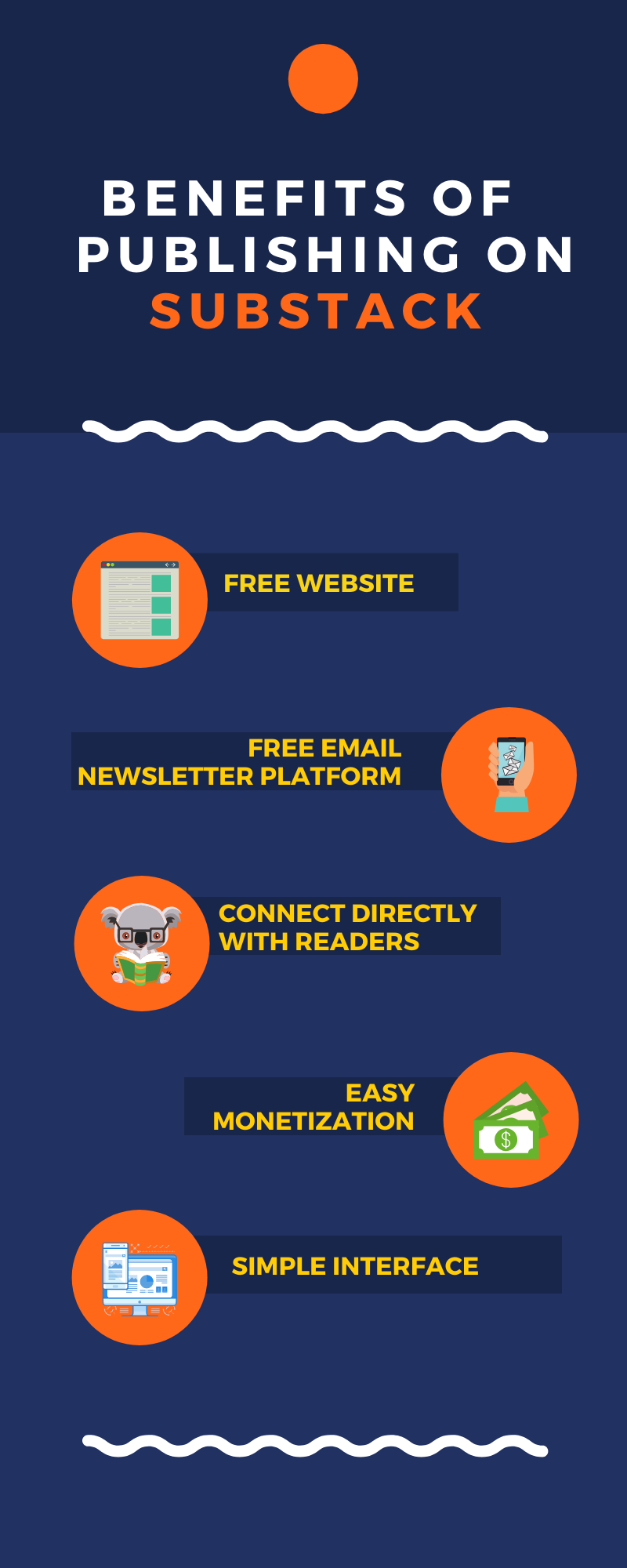Substack is described as an email newsletter platform that is designed for small publishers who hope to turn their subscribers into paying clients. Freelance writing is a great hustle that can easily turn into a massive hassle. Writes must pitch editors, sign contracts, chase invoices, and then write.
But, what if writers can skip all these processes and just write? They can get a content management system (CMS) designed for publishing email newsletters, linked to Stripe for payments, and a site that can host free and subscriber-only content. Substack makes it simple for the writers to launch the paid or free newsletters.
The platform is an email newsletter with a twist. It lets users charge a subscription fee which means that the writer can write and publish anything they want while giving their audience a means to pay them.
One example is Jen Billock who has successfully used Substack to turn her food-and-witchcraft newsletter, Kitchen Witch, into a method of making extra money. She gained more than 250 subscribers in the first month and 8% of them pay $5 per month for premium subscriptions.
Billock teaches other writers to produce one newsletter per week and then sends them to her subscribers. She said:
“I love writing about witchcraft, but I’m not gonna write about it for free. So one of my goals was to provide an outlet for people like me: who are writers, who are witches, who want to write about the topic, but don’t want to spend time writing for nothing.”
How To Work With Substack
Setting up a Substack newsletter is easy and free. First, choose a niche. Most of the top newsletters running on Substack focus on a particular topic, like climate change, China, or productivity. But, for anyone who does not want to be limited to one topic, some newsletters showcase writers’ writing skills.
After choosing a niche, it is now time to set up a newsletter through Substack. The writer needs to choose a URL where their newsletter archive is hosted. Then, choose the available setting and even limit permissions on who can comment on the published content.
The platform has an intuitive word processor built into their site where a writer can write and format their post. There is also support for embedding photos, videos, and audios within the newsletter.
A writer needs to double-check their formatting and spellings. Ensure that everything is polished before scheduling a newsletter to go out to the readers. Experts advise writers to focus their content around their editorial vision. If a newsletter is about blockchain, they should not send a random newsletter about pet care.
Always stick to a schedule by creating an editorial calendar that schedules posts in advance. This strategy keeps the writer honest and also gives the readers something to look forward to.
Finally, ensure that people know about the newsletter. Writers can start by importing their existing email contacts including family and friends who are interested in keeping up with their work. Posting on social media, advertising online, and connecting with other newsletter writers for cross-promotion has also been proven to work.
How Substack Helps Writers
Starting a site dedicated to covering a niche topic and make some money from it without running ads on the site requires some work. If a writer does not have a product of their own to sell, they can monetize their content by selling subscriptions to loyal readers.
To achieve that, one needs to develop and maintain a site, integrate a payment solution to manage subscriptions, create a funnel by offering limited free content, and then restrict access to the remaining content for the loyal audience to subscribe.
Substack offers all these tools via an email newsletter platform that enables everyone, irrespective of their tech experience, to monetize their content through selling subscriptions. Substack’s business model charges a 10% commission of every paid subscriber in exchange for the tools it offers the writers.
The writers that do not want to monetize their content can use the platform for free. The Substack CEO, Chris Best, once said:
“The goal is to allow writers and creators to run their own personal media empire.”
In February 2019, the platform introduced audio content support for the content creators that want to sell podcast subscriptions to their subscribers. Substack for podcasts works similarly to the written publications. The content creators can give audio content accessible to anyone or just their subscribers.
The platform gives the authors a sense of freedom because they are no longer limited to the regulations of one social media platform. It increased the connection between readers and writers enabling the content creator to publish unique content suitable for a specific audience segment, while still being compensated fairly.
Through Substack, authors have the option of charging for access to their writing, offer free content, or combine both strategies to suit their subscribers. Andreessen Horowitz is an early Substack investor. He stated:
“This is where Substack lets writers — of all kinds — directly connect with their readers. Because email is an open platform, it’s durable: It was invented almost alongside the early days of the internet, and is here to stay. It’s also portable: You can take your email addresses with you if you switch providers, offering a degree of control beyond what social media and even RSS offered in terms of audience portability (as I and many other niche content creators on the internet learned the hard way).”
The timeframe for creating relationships over email is infinite. It is not limited to how long a platform may survive or decide to switch its business model.
Going Premium With Substack’s Newsletter
After setting up a newsletter and advertising it all over to attract a viable audience, it is time to get paid. All newsletters are automatically sent out freely. Hence, to make some money, the writer needs to earn subscription revenue.
Users can go for a paid subscription with no extra content. This method is for the writer that wants to give people the option to support their work and they are not interested in keeping any content behind a paywall. The paid subscription is activated as a way to show support.
In another strategy, all content is made available exclusively to the paying subscribers. If people want to see such content, they have to pay something.
Finally, some writers keep some content and publish it exclusively to the paying subscribers. In this case, the writer sends some free newsletters but also keeps exclusive content for the paying subscribers. Notably, most of the newsletters prefer this strategy. The free content is used as an advertisement to attract more subscribers where some of them willingly upgrade to the paid plan later on.
Experts estimate that around 5-10% of subscribers choose to go paid. That percentage may appear small but the numbers can add up. For someone with 500 subscribers and 50 of them decide to pay $5 per month, that turns into $250 gross revenue each month. Once Substack deducts its 10% fee and Stripe’s credit card fee of 2.9% + $.30, that amount is around $200.
Depending on a writer’s place of residence, they might pay income tax of probably 20%. If the content creator spends 10 hours per month on their paid newsletter, they are working for around $18 per hour which is a decent income.
Substack Pros
The platform is flexible and user-friendly. Drag-and-drop tools make it easy for the users to incorporate audio files and images into the newsletter. The writer can format a professional and attractive newsletter in around 5 minutes on Substack.
As a freelancer, one needs to convince a client to buy their work before it ever sees publication. But with this platform, the only people that the content creator needs to convince are the readers that can subscribe and unsubscribe willingly. For the upcoming writers, launching a Substack gives them writing samples that can get them more work or get paid right away.
Newsletters on this platform cover all imaginable niches, from witchcraft to data, and the writer can write on anything they want. If there is no paying market for a particular niche, a writer can create one.
Shortcomings
Building a mailing list takes time and effort. Then, convincing the subscribers to pay for the content is also challenging. It is tough to get people to spend at least $5 per month on one newsletter which is Substack’s minimum monthly fee. Although it is possible to set a lower yearly price, the relatively high monthly minimum may prevent some of the subscribers from opting in.
There are a lot of fees involved when using Substack. The platform charges 10% fees, Stripe takes 2.9% and then there is a $.30 per transaction fee. On top of that, income tax is charged on the writer’s earnings. That translates to a lot of money going to the fees and taxes.
Is Substack Worthwhile?
The truth of the matter is that this platform is not right for everyone. For the established writer who is already making good and steady money, there is no need to invest time in creating a subscriber list. Also, for those who are not writing, there are many other opportunities available.
Substack works well for the emerging content creators who can take low pay at first. If they gain at least a few paying subscribers, it can become an apprenticeship opportunity. The writer makes a little money as they learn what the writing world is all about. Then, writers can send their best work to editors when they are ready to advance to the next level.
The hobbyist who has a big audience can also benefit from the platform. If one has 10,000 followers on their different platforms, they can benefit from Substack since fans of niche hobbies are more likely to pay for the content.
For the established writer with editing skills and has some time to spare, Substack can help them make money on their terms. They can also grow their publication by soliciting other writers’ work.












